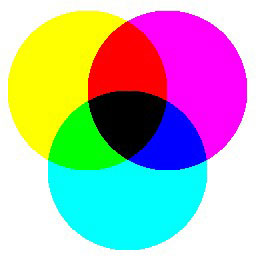CMYK: cyan, magenta, yellow, black
This scheme is also known as process color, since it is used to print full-color images (such as photographs) with only four passes through the printing press—one for each color of ink. CMYK is a subtractive system, since it deals with light that is reflected from the printed page.
What we preceive as color on a surface actually is the result of ink (or paint, or tree leaves) absorbing some of the frequencies of the light that is striking it. When you compare CMYK to RGB, you will see that they are exactly complimentary (opposite). This is because cyan ink absorbs red light and reflects green and blue—remember than green + blue light = cyan. If we want a printed surface to appear blue, we need both cyan ink (to absorb red), and magenta ink (to absorb green)—so the only additive color left to be reflected is blue.
Values for C, M, and Y are specified in percent (0-100; larger numbers are darker). Since even 100% C+M+Y does not result in a really perfect black (due to limitations of the printing process and inks), a fourth run through the press is made with black ink (also specified in percent, just like the grayscale). Full-color images are prepared for printing by making color separations—one black-and-white image for each of the primary color components. Modern graphics software will do this automatically. The printer’s job is to get the four passes through the press lined up exactly on top of each other; this is checked with small crosses outside the image itself, which are known as registration marks.
Desktop color printers—inkjet or laser—also use CMYK inks or toners, but work in one pass for an image (with multiple nozzles per pixel). Professsional inkjet photographic printers may add intermediate ink colors such as light cyan or even orange. Again, software for each specific printer model will do all of the conversion work for you.

Primary colors:
cyan, magenta, yellow
Secondary colors:
blue = cyan + magenta,
red = magenta + yellow,
green = yellow + cyan.
All colors:
black = cyan + magenta + yellow (in theory).
Black (K) ink is used in addition to C,M,Y to produce solid black.
white = no color of ink (on white paper, of course).